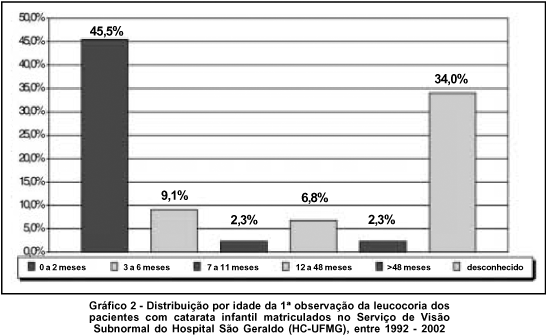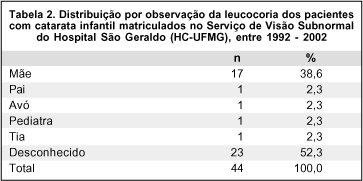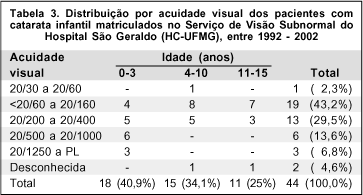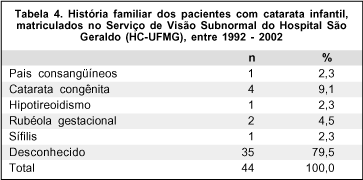PURPOSE: To establish the frequency of infantile cataract in the Low Vision Service of São Geraldo Hospital (HSG-HCUFMG) and to analyze basis of history, ophthalmologic examination and optical prescription in these patients. METHODS: Retrospective study of infantile cataract recorded in the Low Vision Service from January/1992 to December/2002. Age, sex, race, age at the first evidence of leukocoria and who noticed it, ages at diagnosis and phacectomy, family history of cataract, intraocular lens implantation, visual acuity (VA) and optic prescription were evaluated. RESULTS: There were 44 patients. The age ranged from 0-15 years: 19 (43.0%) 0-3, 14 (32.0%) 4-10 and 11 (25.0%) from 11-15 years. Twenty-eight (63.6%) were female and 19 (43.2%) leukodermic. The first evidence of leukocoria was observed by the mother in 17 patients (38.6%). Leukocoria was observed in the first 2 months of life in 45.5% of the patients; phacectomy was performed in 43.2% of the patients with more than 1 year of age. Optic prescription was performed in 61.4% of the cases with 9.1% of the patients below 1 year of age. Intraocular lens was implanted in 13.6% and 4 patients (9.1%) had a family history of congenital cataract. In 20.4% VA was lower than 20/400 and secondary glaucoma was observed in 18.2% of the cases. Low vision aids included two glasses and one telescope. CONCLUSION: More information about congenital cataract should be provided for families and pediatricians, and early surgical treatment, optic correction and treatment of amblyopia should be performed promptly.
Cataract; Cataract; Cataract; Vision low









